11/30: Data Sizes Buz Words
11/24: Solution Lifecycle
Category: Best Practices
Posted by: bagheljas
Cloud Readiness of an application system deployment in IaaS service model is dependent on the following factors:
- Technology: Operating systems and middleware technologies are capable to run on x86 server architecture platform also known as x86 server platform. The most commonly used operating systems over x86 server platforms are Windows and Linux operating systems and widely available as IaaS from several vendors such as Savvis, Rackspace, Terremark, and Amazon.
- Implementation: We often find that our implementation is not compatible to run on x86 server platform and have direct dependency on the server hardware platform. In order to be cloud ready, it needs to be on a x86 server platform with no direct dependency on the server hardware platform.
- License and Support: This one tightly aligns with the products used for implementing the application. Product vendor needs to support and economical license options for an application system deployment in a public and private cloud deployment. You may find that to overcome of license constraint people produce a dedicated cluster for certain technology component such as Oracle Database.
- Scale and Performance: The public cloud vendors normally will not guarantee the performance for disk and network IO. You will find dedicated CPU and Memory with System Availability commitments from the public cloud vendors. If an organization got its own scale to operate and has strict performance requirements around disk and network IO and doesn’t need to scale (beyond pre-defined limits) without a lead time are implementing a managed private cloud.
- Security Mandates: The most difficult security mandates to meet by a public cloud vendor is that my data needs to stay physically separated from others. In that case, you are required to implement a private cloud. The security mandates that requires data to be encrypted over wire and rest and who can access can be met by a public cloud vendor offering using software based controls. We may find that organization go for a hybrid model where you hand pick what to share (software controls meets your security mandates) and what you won’t (you will need to have hardware controls in place to meet your security mandates). Cloud provider such as Savvis specializes in the creating the Hybrid System Deployment to meet the Enterprise Cloud Computing (ECC) needs.
11/16: ITO Architecture Layers
Disclaimer
The views expressed in the blog are those of the author and do not represent necessarily the official policy or position of any other agency, organization, employer, or company. Assumptions made in the study are not reflective of the stand of any entity other than the author. Since we are critically-thinking human beings, these views are always subject to change, revision, and rethinking without notice. While reasonable efforts have been made to obtain accurate information, the author makes no warranty, expressed or implied, as to its accuracy.
The views expressed in the blog are those of the author and do not represent necessarily the official policy or position of any other agency, organization, employer, or company. Assumptions made in the study are not reflective of the stand of any entity other than the author. Since we are critically-thinking human beings, these views are always subject to change, revision, and rethinking without notice. While reasonable efforts have been made to obtain accurate information, the author makes no warranty, expressed or implied, as to its accuracy.




